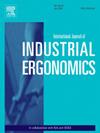Identifying the impact of robot speed and task time on human-robot collaboration through facial feature analysis
IF 2.5
2区 工程技术
Q2 ENGINEERING, INDUSTRIAL
International Journal of Industrial Ergonomics
Pub Date : 2025-01-01
DOI:10.1016/j.ergon.2024.103691
引用次数: 0
Abstract
The increasing involvement of collaborative robots (cobots) has led human workers to perform more value-added tasks, but with greater mental demands. In order to properly design tasks that protect worker long-term health, it is important to be able to detect and quantify stressors (robot speed and task time) that increase mental workload in human-robot collaboration (HRC). In this work, HRC task conditions (robot speed and task time) were classified based on changes in facial features, a non-intrusive stress indicator that has rarely been investigated for HRC. Twenty participants performed an assembly task in a seated posture under both high and low robot speeds, and for a prolonged duration. The results showed stress level and mental workload were higher at high robot speed compared to low speed. For the high-speed setting, a higher stress level was observed at the end of task compared to the beginning. For task classification, a random forest model was able to classify task conditions for robot speed and task time with accuracies greater than 97%. The lip corner movement was the primary facial feature change across classification tasks. These results support the use of facial feature changes to detect worker response to stressful conditions in HRC.
通过面部特征分析,识别机器人速度和任务时间对人机协作的影响
越来越多的协作机器人(cobots)的参与使得人类工人执行更多的增值任务,但对智力的要求也越来越高。为了正确设计保护工人长期健康的任务,能够检测和量化在人机协作(HRC)中增加精神工作量的压力源(机器人速度和任务时间)是很重要的。在这项工作中,基于面部特征的变化对HRC任务条件(机器人速度和任务时间)进行分类,面部特征是一种非侵入性压力指标,很少对HRC进行研究。20名参与者在机器人高、低速度和长时间的情况下以坐姿完成组装任务。结果表明,与低速机器人相比,高速机器人的压力水平和脑力负荷更高。对于高速设置,在任务结束时观察到比开始时更高的压力水平。对于任务分类,随机森林模型能够对机器人速度和任务时间的任务条件进行分类,准确率大于97%。在分类任务中,唇角运动是主要的面部特征变化。这些结果支持在HRC中使用面部特征变化来检测工人对压力条件的反应。
本文章由计算机程序翻译,如有差异,请以英文原文为准。
求助全文
约1分钟内获得全文
求助全文
来源期刊
CiteScore
6.40
自引率
12.90%
发文量
110
审稿时长
56 days
期刊介绍:
The journal publishes original contributions that add to our understanding of the role of humans in today systems and the interactions thereof with various system components. The journal typically covers the following areas: industrial and occupational ergonomics, design of systems, tools and equipment, human performance measurement and modeling, human productivity, humans in technologically complex systems, and safety. The focus of the articles includes basic theoretical advances, applications, case studies, new methodologies and procedures; and empirical studies.

 求助内容:
求助内容: 应助结果提醒方式:
应助结果提醒方式:


